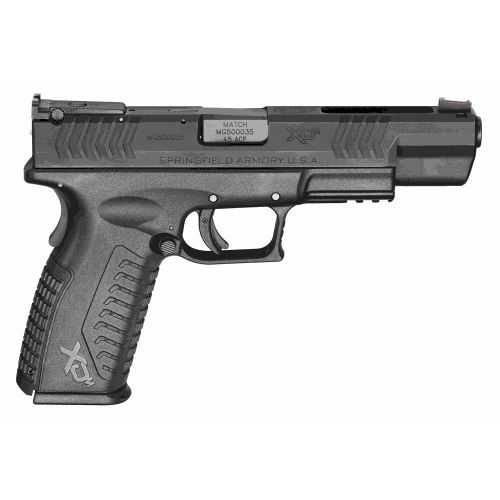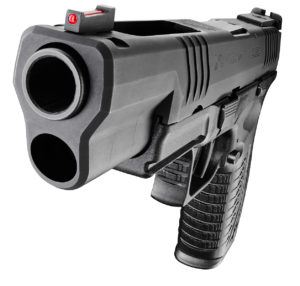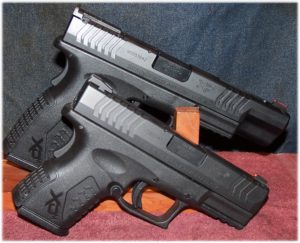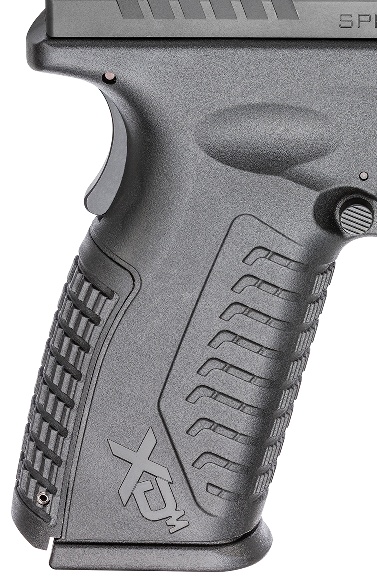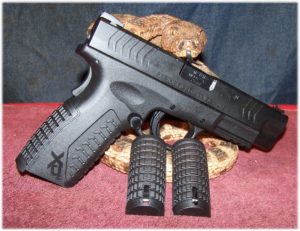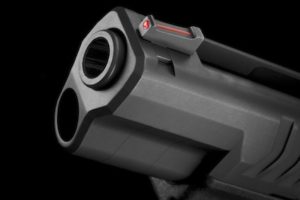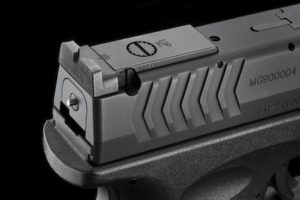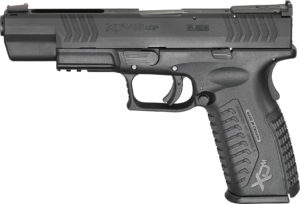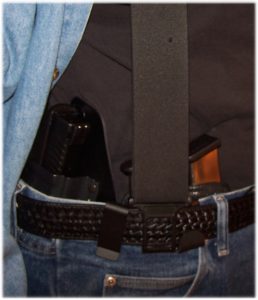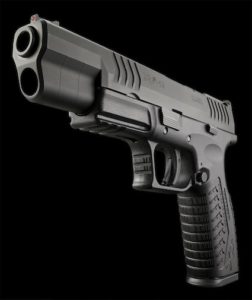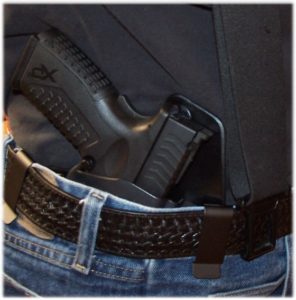I have long been a fan of Springfield Armory products. I would say that Ruger and Springfield Armory (mentioned in alphabetical order simply not to place one above the other) comprise the majority of firearms in the collection.
It could be said that the .45 ACP is my favorite cartridge and it would not be incorrect in saying that, and I have several Springfield Armory semi-automatic pistol chambered in that specific cartridge. There was a desire in me; however, to expand my Springfield horizons and go big. Big, in this sense, meant a long-barreled semi-automatic polymer pistol chambered in my favorite cartridge. The Springfield XDM MOD 2 has a 9mm version with a 5” barrel, but that wasn’t going to satisfy me. I needed bigger! The XDM 5.25 seemed to be the only direction to go in the Springfield line.
Of course, there are other “Competition” pistols on the market in .45ACP, the Glock G41 GEN4 .45 AUTO CHAMPION for one with its 5.31-inch barrel and its capacity of thirteen rounds, and also a plethora of 1911 “Long-Slide” pistols intended for competition. Smith & Wesson also has a line of “performance” pistols, but at this time the .45ACP is not among them. Essentially, the choices come down to Glock or Springfield Army for the polymer family of (affordable) performance products.
The truth of the matter is that deciding on the Springfield XDM 5.25 was a very easy decision to make and was based on my short experience with the XDM 3.8 and XDM 4.5 versions.
The Glock G41 GEN4 .45 AUTO CHAMPION was out for its sheer size, because I had another intention for the pistol and I needed to know my limits according to my intentions. I had authored an article regarding competition pistols for home-defense purposes (Long Slide Competition Pistols – For Home Defense?: https://guntoters.com/blog/2015/03/07/long-slide-pistols-for-home-defense/), but my intention for the Springfield XDM 5.25 was to go beyond home defense and into the EDC personal defense arena.
You see, carrying a “Government” model 1911 with a five-inch barrel is not a big thing for me; I have been doing it for years IWB and concealed. My evolving into the polymer pistol arena gave me pause for thought about just how big, at the minimum, does a pistol need to be before I could no longer conceal it effectively – seasonal considerations aside. For me, the Glock G41 would push me past my limits for concealed carry. The Springfield XDM 5.25; however, may just be within the realm of reason with an appropriate holster and clothing combination – even in the hot Georgia Summer sun.
Although I do like stainless-steel, I opted for the Melonite version because my intention for the pistol was not for competition. Also, I wanted to make the XDM 5.25 part of the family and a stainless-steel version may feel like a red-headed step-child among the rest of the kids.
The purpose of this product review is not only to provide information regarding the Springfield XDM 5.25 Competition Model, but also to test the viability of carrying such as pistol as a PDA (Personal Defense Assistant). In short, the write-up may get quite lengthy. So, jump on board and enjoy the ride.
THE BASICS:
VISUAL APPEAL:
It seems lately that some manufactures are going all out in texturing pistols for appeal and they may be going way overboard in that department. There are people who like clutter and people who do not like clutter. Fashion over form seems commonplace with some pistol designs. Fortunately, Springfield has not completely succumbed to that thinking and has attracted and retained some customers, including me, because of that fact.
Of most of the pistol manufactures, I think that Glock and Springfield are visually appealing pistols. The clean lines of the Glock pistol are obvious and are visually appealing. Springfield Armory has an appeal of its own, although the pistols are somewhat cluttered. Clutter; however, can be made to seem uncluttered. Springfield Armory has, what I believe to be, uncluttered clutter. The Springfield XDM 5.25 exhibits blended lines but yet an aggressiveness in texture where needed.
The 5.25-inch barrel and grip size lends to the balanced look of the pistol. The barrel length, in my opinion, is more befitting the grip length than is the barrel length of the XDM 4.5.
The XDM 5.25 is not a svelte pistol in any form or fashion. It is a handful of pistol and in no way is “compactness” one of its virtues. The XDM 5.25 indicates that it is all business, but can be used for pleasure as well.
The XDM 5.25, for all appearances, is a well-made, heavily-constructed pistol. The XDM 5.25 simply looks like a heavy-weight contender, and the truth of the matter is, it is.
THE (LONG) SLIDE:
The slide of the XDM 5.25 is not the longest of polymer pistols in the .45 ACP class room; the Glock G41 with its 5.31-inch barrel, takes that honor (as far as I am aware of). Forty-three separate components comprise the complete slide assembly.
The slide, like other XDM products, is nicely contoured at the top to reduce the slide’s profile. One major difference between the XDM 5.25 slide, and what is not found in other XDM pistols, is the lightening cut in the slide that reduces reciprocating mass, which allows for faster cycling and allows a larger variety of loads to be used. Overall, the weight of the XDM 5.25 (32 ounces) is only one ounce heavier than the XDM 4.5 model, but is five ounces heavier than the XDM 3.8 Compact model. The Glock G41, by comparison, is twenty-seven ounces (dry w/magazine installed).
Fully receiving the Melonite treatment, the finish is durable as it is pleasing to look at. Adding to the pleasurable appearance is the way the Springfield chose to contour the dust cover rearward rather than it having a simple “blunt” end. This feature adds a stylish rake to the front end of the pistol, don’t you think?
Chevron serrations front and real provide a good surface for the hand when manually cycling the action. The serrations are bold but are not obtrusive to the hand. I have tried the “Israeli Method” of racking the slide, and while this does take some strength, the serrations are helpful in performing this method.
“Bill-boarding” is seen throughout the slide in the form of laser etching. I really don’t mind the Springfield logo laser etched on the top of the slide just forward of the chamber. I do think that some of these manufacturers should take up the Rock Island Armory model of “less is more” in their “bill-boarding” of pistols. Besides, trying to read all the laser etching while the slide is in operation is impossible.
The finishing on the inside of the slide is impeccable and everyplace that should be shiny and/or polished is and free of the Melonite treatment.
The 5.25-inch barrel is a substantial piece of steel that has received the Melonite treatment with the exception of the chamber and the inside of the barrel. A fully supported and highly-polished feed ramp ensures positive feeding as does a very stout, non-captured spring and a full-length steel guide rod recoil system. The 5.25-inch barrel translates into a slight gain in velocity, a longer sight radius, and depending on the operator – a slight gain in accuracy. In competition, a long barrel is a plus, but is it a negative when trying to conceal the pistol for every day carry? More on concealing the XDM 5.25 to come.
The Recoil Spring and Recoil Spring Guide Rod are separate units; they are not captive as with the XDM 3.8. The Recoil Spring Guide Rod has also received the Melonite treatment The Recoil Spring has a substantial spring rate that I would estimate to be around eighteen pounds. It is interesting to note that the Recoil Spring and Recoil Spring Guide Rod are identical to that of the XDM 4.5.
As with all XDM pistols, the extractor is internal to the slide, that pleases me, and it seems to perform its job well as boinks to the head, neck, and arms is evident by expended cases being bounced off of the firing lane wall, which also means that the Ejector is doing a fine job. The ejection port is more than adequate enough to ensure that expended cases are expelled without interference.
At the rear of the ejection port sits a spring-loaded “Loaded Chamber Indicator” that is both tactile and visual.
Just rearward of the “Loaded Chamber Indicator” is a hole that a lot of people associate with the Loaded Chamber Indicator but, in fact, is not. The hole is for the Striker Retainer Pin, which holds the striker in place during normal operation. Because of Striker Retainer Pin, I have heard that excessive dry firing of the pistol should be avoided without the use of a Snap Cap, which will prevent the Striker from deforming the Striker Retaining Pin.
At the rear of the slide is the Striker Status Indicator that informs you if the firearm is ready to fire whether the firearm is loaded or not. If the Striker Status Indicator” is visible, the pistol is cocked. The Striker Status Indicator is under spring tension. When the Striker is forward, the Striker Status Indicator cannot be seen and the striker is not in a cocked condition. When the Striker is rearward (cocked), the Striker Status Indicator is visible.
TALK TO THE HAND – THE FRAME:
The frame texture and feel is the same as with the Springfield 4.5, but if you have not handled the Springfield 4.5 allow me to state that it is very nice. Fifty-three individual parts (including 5 magazine parts and excluding two interchangeable back-strap adapters) make up the synergetic frame.
The meta-reinforced polymer frame is substantial and, in many ways, I feel is superior to the frame found on Glock pistols. My hand just falls right into place on the XDM 5.25 (in fact, on all of the XDM models) due to the grip angle; whereas, with the Glock pistol (any of them) it seems that my hand is constantly searching for that “sweet spot.”
For you folks who just demand that a pistol must have a means of attaching accessories, the XDM 5.25 will meet that demand. An under-rail with three slots should allow the mounting of your favorite light, laser, light/laser combination, or even a very small vertical hand-grip. Since I like a snack during a good gunfight, I just may rig up a mount to hold a couple of “Slim Jim” min-bites.
Just rearward of the rail, you will find the serial number plate.
The texture of the grip area, while aggressive, is not so aggressive that it hurts the hand and/or leaves impressions in the hand as with the XDS series of Springfield pistols. The hand just seems to gravitate to the texture naturally. The XDM 5.25 (and XDM 3.8 Compact and 4.5) is just one of those pistols where I don’t feel like the pistol is sliding around in my hand and that means quite a bit in regards to control and handling of a pistol.
The only thing that I would like is finger grooves, but that is a personal “like” and I could add a grip sleeve with finger grooves to the handle, but that would increase the width of an already wide grip. As it is, the grip is just fine for most uses. After getting used to a “finger groove” grip on my 1911 pistols, I just feel a “wanting” on other pistols.
Also included in the grip area is more “bill-boarding” in the form of XDM, MADE IN CROATIA, and SPRINGFIELD INC. GENESERO ILL.
Whether you are a right or left-handed shooter, there is a nice groove in the upper part of the grip that the thumb seems to just fall into. The “groove” also serves as a guide for the trigger finger to the trigger on the opposite side of the frame. If you are a “high-thumbs” shooter, as I am with a 1911, the thumb grooves take a bit of getting used to, but using them keeps my thumb away from the Slide Lock Lever; the pressing of which could result in a failure of the slide to lock back on the last round.
The frame railing is a two part system; a substantial front rail that is part of the locking block, and a substantial polymer rear rail that is part of the frame. The slide-to-rail fit is excellent.
One of the features of the XD line of pistol that I can appreciate is that the Locking Block is robust and well-embedded into the meat of the frame. One of the failings of the Glock pistol (excluding the G43 and G42) is that the area surrounding the upper Locking Block pin is susceptible to damage after very high round counts or the over-use of +P ammunition. I have personally seen two examples of cracked Glock frames at this point of contention. The Locking Block in the XDM is well-designed and well-mounted, in my opinion.
The frame incorporates the Disassembly and Slide Stop Lever (See, I AM IN CONTROL).
One of the features of the XD series of pistols is the integral Grip Safety; one of the features that many of us 1911 operators appreciate. The Grip Safety must be pressed to fire the pistol. The Grip Safety must also be pressed to move the slide to the rear, which may be awkward at first for some, but is easily managed by most.
The trigger guard incorporates a serrated front finger rest for those who prefer one. The trigger guard is large enough for a gloved hand and the frame incorporates a slight well to the rear of the trigger guard to help the rest of the fingers to get as close to the bottom of the trigger guard (and high on the back-strap) as possible.
The trigger incorporates the now-seems-to-be-standard integral Trigger Safety Lever (otherwise known technically as the Trigger Flapper). The trigger finger must be inserted fully into the trigger guard and engage the trigger face, which allows the trigger to be pulled rearward. There is more information about the trigger characteristics in TRIGGER.
The trigger reach (the distance from the center of the trigger face to the rear of the back-strap with the grip safety pressed) is approximately 2-5/8 inches. This means that folks with small of chubby hands should have no problem reaching the trigger and selecting a grip insert for your hand may help in that department.
The XDM 5.25 came with three back-strap grip adapters. The No 1 (the smallest) grip adapter was installed on the pistol out of the box and will remain on the pistol for my hands. That may sound funny coming from somebody who sometimes puts grip sleeves on Glock pistols to increase the grip width, but the grip of the pistol feels right for my hand. Given the grip angle of the pistol, the grip has the feel of a 1911 or a CZ75 and I like that feeling.
The pistol has an excellent beaver-tail area that aids in getting the shooting hand high on the back-strap but eliminates any concern about slide bite.
The grip is wide and long and there is no doubt about that. There is enough space to place all of my fingers around the grip area with a bit of grip left over. The XDM 4.5 grip area is that of a full-size service pistol. The grip area on the XDM 3.8, even with the extended 13-round magazine and grip sleeve, does not feel as good as the grip on the XDM 4.5 and 5.25 for me.
Turning to the magazine well, we find a beveled one, which definitely assists in slapping home a wide-body double-stack magazine, of which the XDM 5.25 comes with three.
Just behind the trigger guard, we find ambidextrous magazine release buttons that should make lefties happy. In fact, they make this “righty” happy when I am operating a pistol left-handed.
The magazine release buttons are extended but not obtrusively so. The magazine release buttons can be operate easily by thumb or finger, but are a little stiff and feel slightly gritty when new; a quick spot of Ballistol during my “prepping” the pistol for duty smoothed-out out the magazine release button stiff and gritty issue. Push a magazine release button and magazines drop free as is to be expected.
SIGHTS:
An obvious advantage of long-slide pistols is the long sight radius. Although the barrel of the Glock G41 is longer, the sight radius of the XDM 5.25 is the longer of the two at 7.25 inches. The front fiber sight is also long (15mm (0.59-inch) compared to the 12mm (0.46-inch) fiber sight of the XDM 4.5. This means that the front sight has more light-gathering capabilities at the expense of being more susceptible to damage.
The fiber front sight, perched just forward of the lightning cut of the slide, is highly visible in daylight and, like the front fiber sight of the XDM 4.5, is one of the few front sights that I can easily pick up in my indoor range. Due to lane lighting and coating on the graduated lenses of my glasses, trying to pick up a dot on a front side is a challenge, but I can see the red fiber bead on the front sight even with the lane lighting off.
Springfield provides additional red and green light pipes with the XDM 5.25 and instructions for mounting the light pipes are included in the User Manual.
The fully adjustable (windage and elevation) rear sight is a simple affair with no dots, no white outline, but a simple black wall (serrated to prevent glare) with a slot in which the front sights set when properly aligned. The rear sight, although adjustable, has a low profile and is not obtrusive as some adjustable sights. For example, the rear “NovaK” style sight that is on the XDM 4/5 is 5.24mm (0.20 inch) in height; whereas, the rear sight height of the XDM 5.25 is 5.53 mm (0.22 inch). That’s only a 0.02-inch difference in height with the factory settings! Having worked with adjustable rear sights on hunting and self-defense revolvers and pistols in the past without issue, I foresee no issue with the rear sight on the XDM 5.25.
NOTE: A rear sight adjustment tool, for adjusting windage and elevation, is shipped with the XDM 5.25; the sight adjusting tool is in the package with the spare front sight pipes.
I am quite used to “slot-dot” type of sighting arrangement and I find the sight arrangement is more than adequate for competition, plinking, or social work. Some who wish to use the XDM 5.25 for HD or as a “duty” carry may opt for a good set of night sights or other sight combination. Both front and rear sights can be removed and replaced with your favorite sight combination, but the work will take the skills of a competent armorer to perform.
TRIGGER:
It has been said that one you shoot one Glock you can shoot any Glock, primarily because the triggers are pretty much the same on all “out-of-the-box” Glock pistols. With some experience with the XDM 3.8 Compact and the XDM 4.5 the same could pretty much be said about the XDM 5.25 version of the XDM pistols. The trigger of the XDM 5.25 feels the same as the trigger of the XDM 4.5 and the trigger of the XDM 3.8 pistol. Springfield claims that all XDM pistols have “match” triggers so it would only seem that all three have the same “feeling” trigger. I like a trigger pull weight to be anywhere from 4 pounds to 5.5 pounds for duty work, although I can work with a heavier trigger. Anything less than four pounds is too light in my opinion for a defensive pistol. However, it can also depend on the trigger’s characteristics. Please, continue reading.
So, let’s talk briefly about the “Match” trigger; the other part of the “M” in XD. First, there is this…
It should be noted that the term “Match Grade” has no objective definition and it is commonly used to describe firearms or ammunition of varying quality and may never be found in use by professional or amateur competition shooters. For instance, both Kimber and Nighthawk Custom fit “Match Grade” triggers; it is difficult to objectively describe the quality of a trigger (even a measurement of 4.5 pounds doesn’t account for creep, over-travel, pre-travel and grittiness), by the same token, it is difficult to dispute the claims of either company. However, the “Match Grade” trigger on a Kimber is nowhere near the quality of that on a Nighthawk Custom. Para-Ordnance claims to use “Match Grade” barrels on even their “Elite” budget priced handguns, but the fitting of the barrel to the slide, frame, link and bushing is critical to accuracy, so the quality of the barrel may be of no consequence to the pistol’s ultimate accuracy potential. Moreover, a truly match grade barrel (in use by competition shooters) from KKM or Bar-Sto will cost nearly a third of the total price of a Para-Ordnance Elite pistol, still requiring careful fitting by a skilled gunsmith, it is unlikely that such expense was taken in the manufacture or fitment of these “Match Grade” barrels. Such comparisons could be made at length, but the consumer should be aware that the term “Match Grade” carries no real, objective meaning within the firearms industry and, in many cases, it may be nothing more than the marketing department doing their job.
– Source: Wikipedia (https://en.wikipedia.org/wiki/Match_grade)
At his point, I will say that the trigger on the XDM 5.25 is slightly better than the trigger on the XDM 4.5 or other XDMs that I own. The trigger on my XDM 5.25 exhibits a short take-up until resistance is felt. Then, there is a small degree of travel through the resistance (about 4.5 pounds by my digital trigger pull gauge) until the striker is released. The let off; however, is crisp. The resistance does not “feel” mushy, although some may say that it does; it just feels like a constant resistance until let-off is obtained. Once resistance is felt, the trigger feels like a very short throw, smooth, double-action trigger with no staging.
The trigger actually feels good, but is obviously different than a 1911 trigger or that found on other pistol that I have operated. The release is very close to the frame and reset is more toward the beginning of the resistance. The trigger actually feels lighter when pulled. Now some may say that 4.5 pounds of trigger pull is too heavy and some may say it is too light. For defensive use, as is the intention of this pistol, the trigger is fine with me and I welcome a trigger that is neither too light nor too heavy to use in a stress situation. The trigger is constant and consistent throughout its operation and that works for me. I am going to say that the trigger on the XDM 5.25 is a “Court Defensible” trigger, I would not modify it in any way, and it should serve fine for most.
Some; however, would trick out the trigger for competition purposes and there are several sources available for parts and custom work. The innards of the XDM are a bit more complex than the Glock pistol due to the grip safety and trigger combination. Personally, I would leave any such work with a competent and qualified armorer. For general and duty use; however, I would not make any changes to the trigger.
But, I would like to go a little further into the XDM operation and especially the trigger because the trigger was one of the factors for my choosing the XDM over the Glock G21 (or even G30).
The XDM design integrates classic auto-loader mechanics with several distinctly unconventional features. The basic operating mechanism employs a familiar Browning-type cam-ramp, tilt-barrel operation with a captive dual-spring recoil guide assembly. The ignition mechanism is striker-fired and requires a partial rearward motion of the slide (approximately 3/4 inch) to cock the system and ready the trigger. If the gun is dry-fired, or in the event of a misfire, the trigger cannot accomplish a repeat strike until/unless the slide is racked. In external aspect, this system appears to operate (and feel) much like the familiar mechanism of a Glock, as does the hinged “Glock-like” trigger-safety lever that prevents rearward trigger movement unless depressed by the user’s trigger finger. However, the actual operating mechanics of the two designs are greatly different.
The XDM mechanism completely cocks (pre-loads) the spring-charged firing pin so that the only function provided by the trigger pull is to release the sear and fire the gun. By contrast, the Glock “Safe Action” only partly pre-loads the firing mechanism, and the trigger pull physically completes the cocking action as well as releasing the firing pin. The XDM is therefore a true “single-action” trigger design because its trigger only performs one function–releasing the firing mechanism. The Glock is a true “double-action” trigger design in that its trigger contributes to the actual cocking of the mechanism as well as releasing it.
To describe the process in detail: After the XDM slide travels rearward about 3/4 inch, the spring-loaded sear “captures” a cocking lug on the firing pin, holding the pin compressed fully to the rear against the pressure of the firing pin spring when the slide travels back forward (either after a short manual retraction of the slide or after the slide’s full rearward travel in the firing cycle). A pull on the trigger then moves the trigger bar and firing pin safety lever linkages forward, which forces the sear downward and away from the striker, and releases the striker to fire the cartridge. The XDM pistol may “feel” like a DAO (double action only) mechanism, but it is not. It acts like a DAO, but it isn’t, mechanically. Springfield’s official term for the mechanism is Ultra Safety Assurance Action Trigger System–or “USA Action” for short. Catchy, isn’t it?
Another unique XDM design aspect is the grip safety that prevents the gun’s trigger from being squeezed unless the grip safety is fully pressed. The XD grip safety also freezes the slide. If the grip safety isn’t pressed, you can’t pull the trigger, and you can’t pull the slide to the rear to load an empty chamber or clear a loaded chamber. You also can’t lock the slide back on an empty gun, whether the magazine is in or out. Plus, there is a separate internal firing pin block that is deactivated only when the trigger is pressed all the way rearward to the point of striker release.
LOADED CHAMBER INDICATOR AND GRIP SAFETY:
A loaded chamber indicator pops up on the top of the slide just to the rear of the chamber when a round is ready to go. This indicator is small, but it can be seen and readily felt for tactile confirmation that you’re ready to shoot. The cocking indicator at the rear of the slide also protrudes to inform you that the striker is set to fire when the trigger is pressed.
The grip safety on the XDM sets it apart from other similar polymer frame/striker fired pistols. The safest manner of carrying a semi-auto with a trigger tab-style safety is to make sure the trigger is covered by a holster. For duty use, this concern is handled by an officer’s duty rig. However, sticking one of these pistols inside your waistband at the end of your shift to carry without your duty holster is not a wise idea.
Clothing can get knotted up inside the trigger guard and press on the trigger as if your index finger was doing the work instead. A holster for this kind of carry is a much safer idea. The grip safety on the XDM lends itself as an extra measure of safety for this type of carry. Even if the trigger is pulled, the XDM will not fire unless the grip safety is also pressed.
The grip safety requires a bit more training and awareness when it comes to clearing a malfunction. The worse-case scenario “Class 3” jam is when a cartridge case is in the chamber and a second loaded round is nosed up against it, trying to feed into the blocked barrel. The slide needs to be locked to the rear to clear this type of problem.
The XDM requires the grip safety to be pressed in order for the slide to be retracted. But, if the pistol twists in the hand and the operator does not keep the grip safety pressed in, the slide will not retract to the rear, but this is only true prior to the point at which the pistol disallows rearward movement. Allow me to explain.
Let’s say that the slide goes forward but is prevented from fully locking up; a condition that might occur during a “stove-pip” jam or a cartridge “nose-dives” into the frame. The slide can still be moved rearward to free the malfunction. There is a point that is approximately ½-inch rearward of the barrel that the grip safety must be pressed in order for the slide to move further rearward. Any distance past this point, the slide can be moved rearward without the grip safety being pressed. Essentially, the point at which the slide is prevented from moving rearward is just about the point when the barrel unlocks and just before the pistol is “cocked.”
I AM IN CONTROL:
In addition to a trigger safety, a drop safety prevents the striker from releasing if the gun is dropped or exposed to a significant impact. As of 2008, 4 inch and 5 inch in XD .45 ACP Service models are available with an optional ambidextrous frame-mounted thumb safety. This option is now available in 9mm, .40 and .45 ACP pistols. As far as I can tell at the time this article is being published, a thumb safety option on the XDM models is not available.
The Disassembly Lever is a simple contoured lever on the left side of the pistol that allows you to remove the slide after the slide is pulled fully rearward and locked into place with the Slide Stop Lever. The Disassembly Lever is nicely serrated to provide a good grip when handling the lever.
The Slide Stop Lever is just rearward of the trigger guard and is easily accessible by the thumb of the shooting hand – in most cases. The Slide Stop Lever is nicely serrated and shaped for friendly operation. The Slide Stop Lever, of course, allows the slide to lock back on the magazine after the last round in the magazine has been fired. It was not intended to be a “Slide Release” and pushing or pulling the slide rearward on a fresh magazine would be best to prevent damage to the slide locking point. During combat or competition; however, I’ll leave the operation of the slide up to the operator.
DISASSEMBLY, INSPECTION, LUBRICATION, AND ASSEMBLY:
Disassembling the XDM 4.5 is not unlike many pistols that incorporate a rotational Disassembly Lever in their design; lock the slide back, rotate the disassembly lever to the vertical position, hold the slide and press the Slide Lock lever to release the slide, and then slowly remove the slide from the frame.
Disassembling the slide on the XDM 5.25 is slightly different due to the coil spring that is not captivated. I place the slide on a soft surface so as not to damage the sights. I hold the recoil spring and guide while pushing the base of the guide rod forward with the thumb of my other hand to push it out of its position on the barrel. I slowly allow the guide rod to move rearward and once I feel all the tension go out of the recoil spring, I then remove the recoil assembly out of the slide.
Springfield does not include lubrication instructions in the manual. Basically I use a light film of Lubriplate NO. 130-A on all slide rails, barrel, lock-up points and surfaces, and any surface that looks shiny. This pistol is not going to be used in harsh climates or conditions. I have used Lubriplate NO. 130-A for years on semi-automatic pistols, rifles, and carbines for years. Your choice of lubricants, of course, is up to you.
During an initial operations check, I noticed that the magazine release assembly was slightly gritty in operations. A very light dab of Ballistol (another product that I have used for years) removed all vestige of grittiness.
Once I was satisfied with my inspection and lubrication attempts, it was time to assemble the pistol. The non-captured recoil spring presents a challenge, as it is quite healthy in spring rate. I found it best to hold the recoil assembly in place with my left hand while pushing against the base of the guide rod until the base of the guide rod fell into its locking notch on the barrel. This does take some “push” and there is a possibility that the guide rod base could slip away from the thumb. The left hand holds the recoil spring as it is being compressed and that helps prevent the recoil assembly from flying away into darkened corners of the room.
Once the slide is fully and correctly assembled, simply install the slide onto the frame, move it rearward until the slide lock point is reached and engage the Slide Lock. Rotate the Disassembly lever down until it is horizontal to the pistol. Grasp the slide and push it to the rear slightly to disengage the Slide Lock. Then, slowly allow the slide to go forward into battery. Perform a function check and you are done.
TRIGGER DAY AND I AM NOT HORSING AROUND:
 My range evaluation day was to be an almost exact duplicate of that I had performed with the XDM 4.5.
My range evaluation day was to be an almost exact duplicate of that I had performed with the XDM 4.5.
A standard silhouette target was positioned ten-yards distant and served quite well as an evaluation point.
Although the magazines do hold thirteen cartridges, I would only load eight cartridges in the three magazines that shipped with the pistol to break the magazines in. Cartridges consisted of; Aguilla 230-grain FMJ (830 fps), Perfecta 230-grain FMJ (850 fps estimated), Georgia Arms 230-Grain FMJ (810 fps), and hand-loads of 230-grain Xtreme FMJ over 5.6-grain of Unique (approximately 850 fps).
Although I had loaded eight cartridges in the first magazine, the first cold-bore, bench-rested shot revealed the “combat” zero. At ten yards, the first shot impacted the target just below the “X” and that meant the sights were spot-on in adjustment for a “muzzle-covered” target. From that point, I moved into off-hand shooting for the remainder of the first shooting session. The pistol performed flawlessly, although the rest of my shooting left something to be desired.
If you have followed any of my reviews, I have often stated my issues with indoor ranges. For some reason, and it may be the coating on the lenses of my glasses, my eyes have a difficult time making out the dot of the front sight on pistol that have them – even night sights. Normally, I just use the front sight profile rather than a dot for sighting. The XDM 5.25 has been the second pistol with which I have actually been able to see the front fiber-optic sight while shooting at my local indoor range – the XDM 4.5 would be the first. Outside, the sights are clear and excellent. The red fiber-optic front sight was very easy to see through the notch of the rear sight. I find that I actually like the simple notch of a rear sight much better than having it adorned with dots or a white outline.
I did learn from the previous session with the XMD 4.5 that I was not gripping the pistol correctly. I was not lining up the pistol with the center line of my wrist; the center line of the pistol was more into the thumb area. I made a correction to my grip, adjusting the back of the pistol to the center of my forearm, and good things began to happen as the pad of my trigger finger fell right into place on the trigger.
I tried a couple of “Mozambique” drills and also a “Stitch in Time” drill where the first shot is to the “X”, the second shot to the “9”, the third shot to the “8” and then continue moving upward into a final head shot. The pistol followed my every move and if my move was off so was the shot; I certainly could not blame the pistol.
The trigger on the XDM 5.25 is excellent. I did not notice any “heaviness” in the trigger – it was just a constant and consistent pull. While the trigger of the XDM 5.25 is not as “nice” as triggers on some of my 1911 pistols, the trigger of the XDM 5.25 is more forgiving in that there is ample opportunity to “back off” of a shot.
The long sight radius is very helpful, the recoil and muzzle flip is mild, and the XDM 5.25 is just a joy of a pistol to shoot. For comparison, I checked out a rental XDM 5.25 in 9mm and ran a full magazine through it. Obviously, the recoil was milder but I did find that I was not as accurate with it as I was with the .45 ACP version of this pistol, but that probably was more me than the pistol.
The XDM 5.25 was going to be a fine firearm to carry for my self-defense needs. So, let’s move on the “carrying” part of the equation.
CONCEALMENT CONSIDERATIONS:
 If you have not realized it by now, the Springfield XDM 5.25 Competition Model, in any caliber, is a large pistol to conceal. It also should be realized that not everybody will be able to conceal this pistol. This part of the write-up is for those who can conceal such a large pistol, and also for those who think that they cannot conceal such a large pistol, but would like to.
If you have not realized it by now, the Springfield XDM 5.25 Competition Model, in any caliber, is a large pistol to conceal. It also should be realized that not everybody will be able to conceal this pistol. This part of the write-up is for those who can conceal such a large pistol, and also for those who think that they cannot conceal such a large pistol, but would like to.
With some clothing, holster, and belt considerations even a large pistol like the XDM 5.25 can be effectively concealed – within reason, of course.
Clothing:
If you like to wear skin-tight blue jeans, the XDM 5.25 may, indeed, not be for you. The XDM 5.25 does take up some space inside the trousers, and when carried in an appropriate holster, having loose-fitting trousers is a definite plus when trying to conceal any handgun – especially a pistol the size of the Springfield XDM 5.25.
A slim dress belt is not going to be a good thing to tighten the trousers with the size of the Springfield XDM 5.25. In fact, a slim dress belt may not work with many other pistols. The belt needs to be of substantial thickness and stiffness to handle the likes of the Springfield XDM 5.25. Personally, I like the “liner” style of belt that has a Velcro inner lining and also for securing the belt. I can adjust the belt to any tightness that I prefer without concerning myself with buckles and holes. You can find “liner” belts at most law-enforcement web-sites and they are available in brown and black and in plain or basket-weave stamping. Regardless of your choice of belts, the belt must be able to pull the pistol as close into the side as possible; you don’t want your butt a-floppn’ in the breeze and the same should be said for the butt of handgun you carry.
My dress is normally casual, as I don’t have to “dress-up” for work since retiring from that corporate impediment to personal growth. My shirts are usually unbuttoned and a “casual” t-shirt forms a barrier between me and the pistol being carried. My shirts are also (at least) one size larger than what I would wear when not carrying. In cooler weather, I may also don a casual, not tactical vest. In cold weather, a vest and heavier outer-coat (or jacket) rounds out the dress requirements. Unless there is an absolute need the shirt, vest, and coat is left not buttoned.
I prefer shirts of somewhat heavier material than dress shirts and blue jean work shirts are worn more often than night. With that said, there are times that I need to casually dress up, the shirt tucked in, and a sport coat worn.
All of my sport coats have been properly tailored for concealed carry (Note: There are plenty of tailors that will help you out in properly fitting a coat for concealed carry if you have a carry permit; for example, Men’s Warehouse). I also prefer my sport coats to be of slightly heavier material to help prevent “printing.” If you are serious about concealing your carry, you need to consider your choice of clothing to not only conceal the carry effectively, but also clothing that won’t hinder access to the firearm.
Holster:
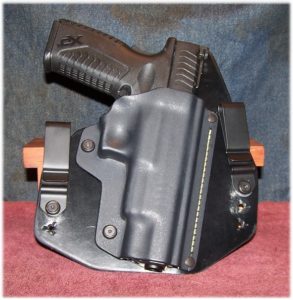
The Springfield XDM 5.25 in one of my favorite holsters – The Black Arch ACE-1 GEN2 – A full Coverage Holster – Note my added front cant
The last thing is selecting a holster that can not only conceal the firearm but also protects the firearm. Since I am talking about “deep concealment” that means a quality IWB holster. While I have several IWB holsters from different holster manufacturers, I prefer holsters from Black Arch Holsters because they not only fit the particular pistol that I may carry, are adjustable in cant and depth, but they also protect the most important parts of the pistol – the trigger and muzzle. Luckily, Black Arch Holsters had the Springfield XDM 5.25 as an option and one was ordered.
As soon as I unpacked the holster, the cant was adjusted to my liking – slightly more forward than the standard fifteen-degree cant. I could not ask for a better carrying holster, as the leather backing started molding to my body shape (I intend to address body shapes in a future article). The length of the holster was no issue even when sitting and the pistol is held securely in place against my side.
With that said, I had to do a light “tweaking” to the trigger guard area of the holster; it was just too tight compared to my other holster. The impression in the Kydex was just a little but deeper than that of my other holster and that made inserting (and drawing) the firearm a bit tighter than I desired. Some minor heating with a heat gun in the trigger guard area and using one of the double-stack magazines that came with the XDM 5.25 helped to raise the trigger area a small amount and the pistol fit was much better. Hybrid IWB holster are known for their retention qualities, but sometimes they can be too retentive.
Regardless of your choice of holster brands, ensure that the holster is of quality material
Extras:
Packing a large and heavy handgun wears you down – especially your britches. For that reason, I also wear suspenders, which helps to support the load of not only the pistol but also loaded magazines or other “load-out” items like flashlights, knives, cell-phones, etc.
In short, dress for success and success is not being “outed” for carrying a concealed firearm.
ADVANTAGES AND DISADVANTAGES OF COMPETITION PISTOLS FOR PDA PURPOSES:
It can be argued that carrying a pistol intended for competition may not be the wisest thing in the world to do because these pistols are for, well, competition and not for self-defense. Let’s discuss that for a bit, since the Springfield XDM 5.25 has been classified (by the manufacturer) as a “competition” pistol.
First of all, before I start this presentation, I’ll state up front that I am not an attorney, nor played one in any form or fashion, and I would not dispense legal information. With that said, please allow me to continue.
If I am forced into using my PDA in a violent encounter, not only will the legality (justification) of such use of force will be questioned, the tool that I used in that violent encounter will also come under scrutiny. There are two words that come to mind; court and defensible. Now, I am not going to go into detail on how I would defend the use of the Springfield XDM 5.25 Competition Model lest this article be read and someone misconstrue my words. Hopefully, I will never have to use this pistol for self-defense – or any firearm for that matter.
The disadvantage of using this pistol for the purpose of self-defense is the stated intent of the firearm by the manufacturer; “The XD(M)® 5.25″ Competition Series is the right pistol for those who are ready to step up their game with a pistol built specifically for competition.” If I can articulate that the features of the Springfield XDM 5.25 actually makes it a better firearm to use for personal defense, than say a firearm that has a highly-modified trigger or sights, my argument may stand. Everything about the Springfield XDM 5.25 leans to a more accurate, safe, and controllable pistol than most. There is nothing about the Springfield XDM 5.25 that says “custom” such as with a “race gun” or a modified pistol. The projectile coming out the barrel is no more “lethal” than a bullet that comes out of the barrel of any other pistol in the same caliber.
I can’t second guess a jury or a prosecuting attorney, but I can tell you this. A violent encounter with an armed assailant is a life and death competition, and there is no guarantee that I will prevail in that encounter regardless of the firearm that I choose to use for self-defense – competition model or not. Self-defense is not a game where advantage points are awarded; “Well, Scott! The figures show that the defender had a 5-point advantage over the aggressor! His pistol had a longer match-grade barrel, a match-grade trigger, a longer sight radius, was of a major caliber and shot more and better bullets!”
The term “court defensible” does not mean justifying a death, it means justifying your life, and I will leave this topic at that.
HOW IT CARRIES:
As I had mentioned in a separate article, most gun-writers will not expound on how well a firearm carries on the person, primarily because there reviews concern the firearm itself and even those reviews can be vague and leaving you wanting more.
Since I have actually carried the Springfield XDM 5.25 Competition Model in .45ACP, I can actually pass on some information as to how the pistol carries.
Whether standing, sitting, bending over, and short of standing on my head or being shaken upside down by a NFL line-backer, I can say that the Springfield XDM 5.25 Competition Model carries surprisingly well. This of course, is dependent upon the holster that houses the XDM 5.25 Competition Model and how well it is adjusted for concealed carry.
With the proper cant, the Springfield XDM 5.25 rides very well when sitting and is very comfortable. Operating a vehicle that has wrap-a-round bucket seats may find one trying to adjust the holster so the butt of the pistol is not being forced into the seat. You may also find that the holster backing is too long for your liking. With the proper holster; however, cant and ride height can be adjusted to your liking, but may be a trade-off between how the holster carries when seated and when standing. Some folks like a high-ride and some-folks prefer a low ride and sometimes there has to be a trade-off between the two.
On a side note, the range and gun club that I frequent had a Customer Appreciation Day recently. I carried in my usual manner as did some other folks. One of the patrons, who CCs a Glock G17, was seated in one of those metal folding chairs while enjoying some of the free barbecue. When he arose from the chair, the entire chair came up with him due to the fact that the butt of the pistol had hooked the chair as he was rising from the sitting position. We all got a good laugh about it, as did the patron. It is just one of those things that happen.
I have covered considerations for carry previously and there is no need to go into that again. If you are not used to carrying a firearm with a long barrel, the feel of the carry will take some time to get used to. For one who has carried a full-size “Government” model 1911 for quite a few years, the only thing that I had to become accustomed to with this pistol was the additional width, and I am not quite there yet, but I am close to considering the “Government” model 1911 as a “compact” pistol compared to the Springfield XDM 5.25 Competition Model.
Now, I am not going to sit and say that the Springfield XDM 5.25 in .45ACP is a delightful carry piece; that would be highly foolish of me. The XDM 5.25 is big and heavy and you just might prefer to carry something of lesser largeness and weight. My point here is that in the right holster, the Springfield XDM 5.25 Competition Model carries comfortably and it is nice to know that I have a few additional cartridges to work with if need be. There are those that would consider carrying the Springfield XDM 5.25 Competition Model as extreme. But, then again, sometime extreme duty takes extreme measures and tools. The Springfield XDM 5.25 Competition Model fits right into that, I think.
Aside from the fact that the Springfield XDM 5.25 in .45ACP is wide and heavy, it is also long. That may turn some off who are used to carrying a much more petite pistol. If you are used to pulling your 3-inch “snubby buddy” from the holster, pulling the XDM 5.25 from the holster just might wear you out to the point that you need to sit down from the exertion of it all. With some practice of pulling the XDM 5.25 from the holster, you will be surprised at just how fast the pistol can be deployed into action.
When I took the XDM 5.25 to the range for the first time it was concealed in my usual fashion. One of my shooting buddies asked me what I was shooting that day. He knew that I had been carrying the XDM 4.5 and was expecting that I would be carrying the same. I said, “Let me whip this thing out!” as I started pulling the XDM 5.25 from the concealed holster. All he could say was, “You gotta be kidding!” I am hoping that a bad guy will say the same thing and stand frozen with shock and awe as the XDM 5.25 is pulled in my own defense.
While the fiber-optic front sight is excellent, I will probably swap it out for a night sight. My idea of competition is a little different than shooting at a target for points. Luckily, the rear sight can be adjusted for any change (within reason) in front sight height.
IN CLOSING:
The Springfield XDM 5.25 Competition Model is a fine example of Springfield quality and dedication to serving the firearms community. Springfield products have been long accepted in the civilian market as they have been in law-enforcement, security, and by the military.
The Springfield XDM 5.25 Competition Model should fulfill your needs for an out-of-the-box pistol that can be used for competition, range duty, home defense, and also personal defense. In short, the Springfield XDM 5.25 Competition Model is a pistol that is “large and in charge.”
By day, the XDM 5.25 is carried concealed and now serves as my PDA. At night, it is slipped from the holster and placed in the night-table ready to take on the role of home defender.
DON’T TAKE JUST MY WORD FOR IT:
Here is a small sampling of other reviews for the Springfield XDM 5.25 in .45ACP:
- XDM 5.25 (Hickok45): https://www.youtube.com/watch?v=l43lVF5uJJ8
- Springfield XDm 5.25 in 45 acp ( Chapter 2 ): https://www.youtube.com/watch?v=5obsWUGVFFM
- Springfield XDm 5.25 in 45 ACP Close-up: https://www.youtube.com/watch?v=3rOq2cV2PCU
Glock 41 vs XDm 5 25: https://www.youtube.com/watch?v=xqVZYm5dkZ4 - Springfield Armory’s XDm 5.25 Competition Series Pistol: https://www.youtube.com/watch?v=lXCneVVi7Go
RESOURCES:
Springfield Armory XDM 5.25 .45ACP Competition Model: http://www.springfield-armory.com/products/xdm-competition-series-45-acp/
![]()



